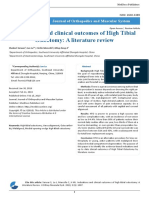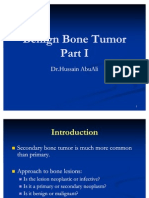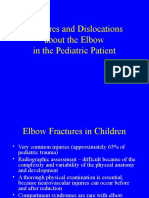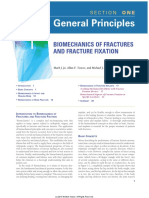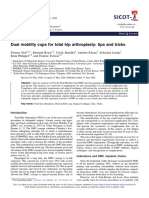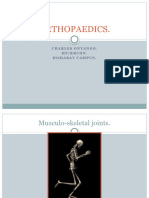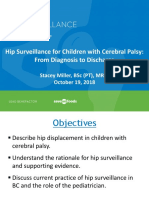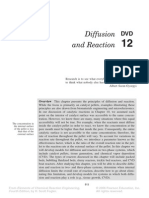0 ratings0% found this document useful (0 votes)
346 viewsBone Tumours: - Jeffrey Pradeep Raj
Bone Tumours: - Jeffrey Pradeep Raj
Uploaded by
jeffreyprajBONE TUMOURS
OBJECTIVES
y Classification of bone tumours y Evaluation of bone tumours y Clinical presentation y Blood, radiological and bone scan
CLASSIFICATION OF BONE TUMOURS
y Osteogenic tumours y Chondrogenic tumours y Haematopoetic tumours y Giant cell tumours y Vascular tumours y Fibrous tumours y Other tumours of the bone y Tumour like lesions of the bone
Osteogenic tumours
y Benign- osteoid osteoma, osteoma,
osteoblastoma y Intermediate-aggressive osteoblastom
Copyright:
Attribution Non-Commercial (BY-NC)
Available Formats
Download as PPTX, PDF, TXT or read online from Scribd
Bone Tumours: - Jeffrey Pradeep Raj
Bone Tumours: - Jeffrey Pradeep Raj
Uploaded by
jeffreypraj0 ratings0% found this document useful (0 votes)
346 views42 pagesBONE TUMOURS
OBJECTIVES
y Classification of bone tumours y Evaluation of bone tumours y Clinical presentation y Blood, radiological and bone scan
CLASSIFICATION OF BONE TUMOURS
y Osteogenic tumours y Chondrogenic tumours y Haematopoetic tumours y Giant cell tumours y Vascular tumours y Fibrous tumours y Other tumours of the bone y Tumour like lesions of the bone
Osteogenic tumours
y Benign- osteoid osteoma, osteoma,
osteoblastoma y Intermediate-aggressive osteoblastom
Original Title
Bone Tumours
Copyright
© Attribution Non-Commercial (BY-NC)
Available Formats
PPTX, PDF, TXT or read online from Scribd
Share this document
Did you find this document useful?
Is this content inappropriate?
BONE TUMOURS
OBJECTIVES
y Classification of bone tumours y Evaluation of bone tumours y Clinical presentation y Blood, radiological and bone scan
CLASSIFICATION OF BONE TUMOURS
y Osteogenic tumours y Chondrogenic tumours y Haematopoetic tumours y Giant cell tumours y Vascular tumours y Fibrous tumours y Other tumours of the bone y Tumour like lesions of the bone
Osteogenic tumours
y Benign- osteoid osteoma, osteoma,
osteoblastoma y Intermediate-aggressive osteoblastom
Copyright:
Attribution Non-Commercial (BY-NC)
Available Formats
Download as PPTX, PDF, TXT or read online from Scribd
Download as pptx, pdf, or txt
0 ratings0% found this document useful (0 votes)
346 views42 pagesBone Tumours: - Jeffrey Pradeep Raj
Bone Tumours: - Jeffrey Pradeep Raj
Uploaded by
jeffreyprajBONE TUMOURS
OBJECTIVES
y Classification of bone tumours y Evaluation of bone tumours y Clinical presentation y Blood, radiological and bone scan
CLASSIFICATION OF BONE TUMOURS
y Osteogenic tumours y Chondrogenic tumours y Haematopoetic tumours y Giant cell tumours y Vascular tumours y Fibrous tumours y Other tumours of the bone y Tumour like lesions of the bone
Osteogenic tumours
y Benign- osteoid osteoma, osteoma,
osteoblastoma y Intermediate-aggressive osteoblastom
Copyright:
Attribution Non-Commercial (BY-NC)
Available Formats
Download as PPTX, PDF, TXT or read online from Scribd
Download as pptx, pdf, or txt
You are on page 1of 42
BONE TUMOURS
-JEFFREY PRADEEP RAJ
OBJECTIVES
Classification of bone tumours
Evaluation of bone tumours
Clinical presentation
Blood, radiological and bone scan
CLASSIFICATION OF BONE TUMOURS
Osteogenic tumours
Chondrogenic tumours
Haematopoetic tumours
Giant cell tumours
Vascular tumours
Fibrous tumours
Other tumours of the bone
Tumour like lesions of the bone
Osteogenic tumours
Benign- osteoid osteoma, osteoma, osteoblastoma
Intermediate-aggressive osteoblastoma
Malignant-osteosarcoma , parosteal ostealsarcoma,
periosteal ostealsarcoma, dedifferentiated
osteosarcoma.
Chondrogenic tumours
Benign-osteochondroma(exostosis),
enchondroma(chondroma), periosteal enchondroma,
chondromyxoid fibroma,chondroblastoma
Malignant-chondrosarcoma, mesenchymal
chondrosarcoma, dedifferentiated chondrosarcoma,
myxoid chondrosarcoma, clear cell chondrosarcoma
Haematopoetic tumours
Malignant-ewing’s sarcoma, plasma cell tumour,
multiple myeloma, lymphoma, peripheral
neuroepithelioma.
Giant cell tumours(GCT)
Benign gct
Intermediate gct
Malignant gct
Vascular tumours
Benign-haemangioma, globangioma
Malignant- hemangiopericytoma,
hemangioendothelioma, angiosarcoma
Fibrous tumours
Benign- nonossifying fibroma, fibrous dysplasia,
desmoplastic fibroma.
Malignant- fibrosarcoma.
Other tumours of the bone
Benign- neurilemmoma, neurofibroma
Malignant- malignant fibrous histiocytoma,
liposarcoma, undifferentiated sarcoma , malignant
mesenchymoma, chordoma, adamantinoma,
parachordoma
Tumour like lesions
Bone cysts-simple or aneurysmal
Fibrous dysplasia-mono or polyostotic
Reparative giant cell carcinoma
Fibrous cortical defect
Eosinophilic granuloma
HISTORY
Pain, mass and disability are the usual presenting symptoms
Pain- benign tumours rarely cause pain unless there is a stress
reaction or a pathological fracture.malignant tumours cause
continuous unremitting unresponsive to oral analgesic and nocturnal
pain.
Onset is acute in malignant tumours an insiduous in benign tumours
Duration: benign tumours- years. Malignant tumours- months
age: certain tumours have predilection to age groups. E.g ewing’s
sarcoma has a predilcction for children
Anorexia, weight loss and fever are more pronounced in malignant
tumours
EXAMINATION
GENERAL EXAMINATION: anaemia, cachexia,
lymphadenopathy, oedema, etc
LOCAL EXAMINATION: to know the extent, plane of
tumour, presence of pathological fractures, etc
JOINT EXAMINATION: to know the involvement of joints,
mechanical effects, etc
NEUROLOGICAL EXAMINATION: to asses the damage to
the peripheral nerves due to spread of tumour and its
infiltration
VASCULAR EXAMINATION: assessment of the arterial
and/or the venous circulation
DISABILITY HISTORY
INVESTIGATIONS
Routine laboratory investigations
Radiological examination of the affected site
Chest radiographs to check for secondaries
CT scan
MRI
Bone scans
biopsy
Ateriograpy to determine the spread of tumour to the vessel
Ultrasonograpy may help in some situations but is of
limited use
Routine Laboratory Investigation
Hb percentage is decreased
Total WBC count and differential count are increased
or decreased.
ESR is increased
Serum phosphorous and calcium is increased
Serum ALP is increased in tumours like osteogenic
sarcoma
Serum acid phophotase is increased in metastses
urianalysis
RADIOGRAPHY
majority of bone tumours seen in
plain x-ray
Beningn tumours show evidence
of chronicity including sclerosis
at the margins of the tumour and
surrounding bone, there may be
matrix formation and periosteal
new bone formation.
Malignant tumours are
characterised by destruction of
bone, permeation of bone and a
poor transition zone between the
tumour and surrounding tissue.
Nuclear medicine
The most common radioisotope used is
technitium-99m labelled methyl
diphosphonate.
It demonstrates increased local turnover
of bone.
It gets incorporated into newly developed
osteoid.
Metastates is indicated by multiple lesions on
the bone scan.
Used to determine the extent of a bone tumour
and to check for prognosis of the patient during
oncological follow up.
Computerised Tomography
It is an excellent
method for cross
sectional examination
of bone tumours.
The image of cortical
and trabecular bone
may be constructed
which can clearly
delineate bone
destruction
Magnetic Resonance Imaging
MRI provides an unsurpassed soft
tissue contrast and is therefore essential
for delineating a tumour
It is also an excellent modality for
demonstrating tumour spread without
intramedullary spread because of the
high contrast provided by the
intramedullary fat
Its routine use is not advocated.
However it is mandatory for the
investigation of primary bone tumours
Functional Nuclear Scanning
Investigations like positron emission
tomography(PET) and thallium scans provide
information about the biological activity of the tumour
It may also indirectly help in determining the grade of
the tumour and areas of tumour that are particularly
active, necrotic or represent recurrent disease.
BENIGN TUMOURS
Osteoma-Seen in adolescents and
young adults. It is of 2 varieties
namely cancellous (exostosis)and
compact(ivory exostosis) osteoma
*cancellous osteoma-conical
lump of bone with a cap of cartilage
arising from the metaphysis of the
long bone.
*compact osteoma-the
membrane bones are affected and
the tumour is sessile. commomnly
seen from the outer surface of the
skull but occasionally can be seen
from the inner surface also.
osteoid osteoma-
children and
adolescent are usually
affected. starts with
pain and an x-ray
reveals a radiolucent
area which may or
may not contain a tiny
dense opacity(nidus)
Osteoblastoma- a larger more aggressive counterpart of
osteiod osteoma commonly occuring in spine
Osteochondroma-benign
cartilage capped bony
projection originating
from the physis and
growing away from the
point towards the
diaphysial region of the
bone. Usually solitary
OLIER’S DISEASE
Enchondroma- asymptomatic
benign cartilaginious neoplasm
within the intramedullary cavity of
the bone. Commonest in the hand.
* Olier’s disease-developmental
conditions
characterised by multiple
MAFUCCI SYNDROME
enchondromas
* Maffucci syndrome-multiple
enchondromas associated with
multiple angiomas.
Chondroblastoma- cartilage
producing tumour with
calcification occuring in
the epiphysis of
children.extremely
painful.common around the
knee
Chondromyxoid fibroma-
has both cartilagenous and
fibrous components. Seen
in the age group of 10-30
years.
Fibroma-the tumour is
an island of fibrous
tissue in the
bone.commonly seen in
adolescents.x-ray
reveals an oval gap in
the cortex of the
metaphysis of the long
bone
Haemangioma-benign tumour of haemangiomatous
origin affecting the vertebrae and the skull. Presents
with dull boring pain and features of cord
compression.
Osteoclastoma(GCT)-benign aggressive tumour with large
oteoclast like giant cells. seen in the age group of 20-45
years. It typically affects the epiphysis of long bones
especially around the knee proximal humerous and distal
radius.
MALIGNANT TUMOURS
Osteosarcoma-the tumour arises from the medulla of the
metaphysis. Gradually the cortex is eroded and the
periosteum is first pushed away from the shaft. There is
new bone formation along with the new periosteal blood
vessels. Haematogenous spread
Chondrosarcoma-a
malignant tumour with
cartilage differentiation.
Long standing symptom
of pain and/or swelling.
Haematogenous spread
and comparatively less
metastatic.
Fibrosarcoma- the tumour
contains spindle shaped
fibroblasts. It may
originate in the medullary
cavity or periosteally. The
patients are usually 30-50
years of age and present
with pain swelling and
even pathological
fracture. This produces
blood-bone pulmonary
metastasis.
Synovial sarcoma- extremely
malignant histologically
comprising of both synovial and
malignant fibroblasts. It arises
close to a major joint like knee
or wrist and metastasis is by
blood, lymphatics or migration
through tissue planes.
Multiple myeloma- arises from the plasma cells of the
bone marrow. Involves the bone containing the red
marrow.(pelvis ribs vertebrae and skull). Characteristic
features are urinary excretion of bence-jones proteins,
abnormal spike in the region of gamma globulin in
electrophoretic pattern, reversal of AG ratio, myeloma
cells in sternal marrow puncture and punched out lesions
in the skull and other flat bones on radiological
examination.
Plasmacytoma- a solitary myeloma with the similar above
said clinical presentation. The patient presents with pain
swelling or a pathological fracture. Radiologically an area
of translucency is observed at the site of tumour.
Ewing’s sarcoma- the tumour
arises from the reticulam
cells of the medullary
cavityof the diaphysis of long
bones. It may gradually lift
the periosteum and deposit
layers of bone giving a
characterisitc onion
appearance in x-ray. common
in males of age group of 10-
20. Poor prognosis. Patient
presents with throbbing pain
worsening in the night.
Malignant fibrous histiocytoma-histiocytic origin.it
occurs in the ends of long bones.it is characterised by
osteolytic lesions with hazy border.
Secondary carcinoma of the bone
Occurs mainly by haematogenous spread.
Primary sites are mainly the thyroid, breast, prostate,
kidney, bronchus,uterus, GI tract and testes
Sites affected are vertebrae ,ribs, sternum, pelvis and
upper end of humerous and femur.
X-ray shows osteolytic(when primary carcinoma is in
viscus)...osteoblastic change( in prostate carcinoma)
Bone scan shows metastatic lesion much earlier than
skiagraphy.
REFERENCES
TEXTBOOK OF SURGERY, BAILEY AND LOVE
MANUEL ON SURGICAL EXAMINATION, S.DAS
TEXTBOOK OF ORTHOPAEDICS, EBENEZER
APLEY’S TEXTBOOK OF ORTHOPAEDICS
INTERNET-PUBMED
You might also like
- 220200820charles SekarDocument103 pages220200820charles SekarABHISHEK SARANGINo ratings yet
- AOTrauma Periprosthetic Fracture Management Thieme 2014Document402 pagesAOTrauma Periprosthetic Fracture Management Thieme 2014Marly OrtopediaNo ratings yet
- Biomaterials Used in Orthopedic ImplantsDocument35 pagesBiomaterials Used in Orthopedic ImplantsFrederik RareNo ratings yet
- Indications and Clinical Outcomes of High Tibial Osteotomy A Literature ReviewDocument8 pagesIndications and Clinical Outcomes of High Tibial Osteotomy A Literature ReviewPaul HartingNo ratings yet
- Brent D. Et Al - Introduction To Pilates-Based Rehabilitation PDFDocument8 pagesBrent D. Et Al - Introduction To Pilates-Based Rehabilitation PDFJuliana CarraNo ratings yet
- ch06 Lecture PPT ADocument93 pagesch06 Lecture PPT ALeona Rabe100% (4)
- Chapter4 Biol102 at 31-10-2016Document66 pagesChapter4 Biol102 at 31-10-2016Abdulaziz AHNo ratings yet
- 15 - Anatomy Mcqs HistologyDocument14 pages15 - Anatomy Mcqs HistologyNasan Shehada100% (2)
- Benign Bone TumorDocument42 pagesBenign Bone Tumorsaqrukuraish2187No ratings yet
- Bone Tumours & Tumour Like C: BenignDocument51 pagesBone Tumours & Tumour Like C: BenignMuhammed Muzzammil SanganiNo ratings yet
- Ultrasonography of the Lower Extremity: Sport-Related InjuriesFrom EverandUltrasonography of the Lower Extremity: Sport-Related InjuriesNo ratings yet
- منهاج الخامسDocument19 pagesمنهاج الخامسDrAyyoub AbboodNo ratings yet
- Fractures and Dislocations About The Elbow in The Pediatric PatientDocument65 pagesFractures and Dislocations About The Elbow in The Pediatric PatientPeter HubkaNo ratings yet
- Chapter 4Document30 pagesChapter 4shreyahospital.motinagarNo ratings yet
- Titanium Elastic Nail PDFDocument27 pagesTitanium Elastic Nail PDFAmith AlankarNo ratings yet
- PJIsDocument29 pagesPJIsMohammed Alfahal100% (2)
- Nonunionconsensusfromthe 4 Thannualmeetingofthe Danish Orthopaedic Trauma SocietyDocument13 pagesNonunionconsensusfromthe 4 Thannualmeetingofthe Danish Orthopaedic Trauma SocietydendroaspisblackNo ratings yet
- FUMC Prospectus 2019-2020 PDFDocument56 pagesFUMC Prospectus 2019-2020 PDFSikandar Hayat KassarNo ratings yet
- Actures - In.adults.8e Booksmedicos - Org Parte4 PDFDocument1 pageActures - In.adults.8e Booksmedicos - Org Parte4 PDFeladioNo ratings yet
- Cards+Against+Paediatric+Orthopaedics+-+Lower+Limbs+ (v1 0)Document142 pagesCards+Against+Paediatric+Orthopaedics+-+Lower+Limbs+ (v1 0)Donna RicottaNo ratings yet
- Long Case OrthopaedicDocument24 pagesLong Case OrthopaedicSyimah UmarNo ratings yet
- Classification AO PediatricDocument36 pagesClassification AO PediatricdvcmartinsNo ratings yet
- Kathy Fagan, MPT University of EvansvilleDocument26 pagesKathy Fagan, MPT University of Evansvilleapi-19729870No ratings yet
- Ortho CompetencesDocument31 pagesOrtho CompetencesHamad ElmoghrabeNo ratings yet
- Basic Principles - Mumbai PDFDocument10 pagesBasic Principles - Mumbai PDFPradipNo ratings yet
- Percutaneous Imaging-Guided Spinal Facet Joint InjectionsDocument6 pagesPercutaneous Imaging-Guided Spinal Facet Joint InjectionsAlvaro Perez HenriquezNo ratings yet
- Ficat and Arlet Staging of Avascular Necrosis of Femoral HeadDocument6 pagesFicat and Arlet Staging of Avascular Necrosis of Femoral HeadFernando Sugiarto0% (1)
- Arthroscopic Ramp Repair No-Implant, Pass, Park, and Tie Technique Using Knee Scorpion, GustaDocument8 pagesArthroscopic Ramp Repair No-Implant, Pass, Park, and Tie Technique Using Knee Scorpion, GustaAlhoi lesley davidsonNo ratings yet
- 1.26 (Surgery) Orthopedic Pathology - OncologyDocument7 pages1.26 (Surgery) Orthopedic Pathology - OncologyLeo Mari Go LimNo ratings yet
- Resource Unit Wound Care EnglishDocument5 pagesResource Unit Wound Care EnglishPeterOrlinoNo ratings yet
- SJAMS 43B 750 754 Thesis Tibial PlateauDocument5 pagesSJAMS 43B 750 754 Thesis Tibial PlateauNisheshJainNo ratings yet
- McKee - Customized Dynamic Splinting Orthoses For Radial Nerve Injury Case ReportDocument16 pagesMcKee - Customized Dynamic Splinting Orthoses For Radial Nerve Injury Case ReportCeauCeauNo ratings yet
- Meniscus Repair Part 1 Biology, Function, Tear.7Document7 pagesMeniscus Repair Part 1 Biology, Function, Tear.7cooperorthopaedicsNo ratings yet
- Chapter 25: Trauma: (Also See Chapter 19, Pediatrics)Document70 pagesChapter 25: Trauma: (Also See Chapter 19, Pediatrics)poddataNo ratings yet
- Orthopaedic Trauma Lecture Notes MBCHBDocument73 pagesOrthopaedic Trauma Lecture Notes MBCHBjhqmpzg7sjNo ratings yet
- Dual Mobility Cups For Total Hip ArthroplastyDocument11 pagesDual Mobility Cups For Total Hip ArthroplastyhardboneNo ratings yet
- Introduction To OrthopedicsDocument4 pagesIntroduction To OrthopedicsSalman MajidNo ratings yet
- AOTrauma Course-Advanced Principles of Fracture Management August 6-8, 2015, Kunming, ChinaDocument20 pagesAOTrauma Course-Advanced Principles of Fracture Management August 6-8, 2015, Kunming, ChinafaluviekadianiNo ratings yet
- Bone Tumours: Natasha Eleena Nor Maghfirah Hani Farhana Nur FadhilaDocument85 pagesBone Tumours: Natasha Eleena Nor Maghfirah Hani Farhana Nur FadhilaWan Nur AdilahNo ratings yet
- Acetabular Fracture PostgraduateDocument47 pagesAcetabular Fracture Postgraduatekhalidelsir5100% (1)
- Bone AgeDocument65 pagesBone AgeueumanaNo ratings yet
- Thesis TopicDocument5 pagesThesis TopicSrikant KonchadaNo ratings yet
- Orthopaedic SlidesDocument163 pagesOrthopaedic SlidesVivian ChepkemeiNo ratings yet
- Peifu Tang, Hua Chen - Orthopaedic Trauma Surgery - Volume 1 - Upper Extremity Fractures and Dislocations-Springer-MSPH (2023)Document308 pagesPeifu Tang, Hua Chen - Orthopaedic Trauma Surgery - Volume 1 - Upper Extremity Fractures and Dislocations-Springer-MSPH (2023)Thiago Longo MoraesNo ratings yet
- Distal Femur (Sandeep Sir)Document22 pagesDistal Femur (Sandeep Sir)Kirubakaran Saraswathy PattabiramanNo ratings yet
- Orthopaedic Surgery Final Logbook Summary May 2021Document7 pagesOrthopaedic Surgery Final Logbook Summary May 2021omar al-dhianiNo ratings yet
- Full Download Essential Orthopaedics 2nd Edition Mark D. Miller PDFDocument64 pagesFull Download Essential Orthopaedics 2nd Edition Mark D. Miller PDForodajutika100% (3)
- Syllabus Ms OrthoDocument8 pagesSyllabus Ms OrthoMuthu KumarNo ratings yet
- The Neglected ClubfootDocument3 pagesThe Neglected ClubfootAngelica Mercado SirotNo ratings yet
- OITE Review 2013 TraumaDocument173 pagesOITE Review 2013 Traumaaddison woodNo ratings yet
- Giant Cell TumorDocument22 pagesGiant Cell TumorMaxmillian Alexander KawilarangNo ratings yet
- Aaos PDFDocument4 pagesAaos PDFWisnu CahyoNo ratings yet
- Bennett FractureDocument5 pagesBennett FractureeviherdiantiNo ratings yet
- Fracture Classifications in OrthopaedicsDocument34 pagesFracture Classifications in Orthopaedicshaswal fazry AwalNo ratings yet
- Hip Surveillance For Children With Cerebral Palsy: From Diagnosis To DischargeDocument59 pagesHip Surveillance For Children With Cerebral Palsy: From Diagnosis To DischargeintannyNo ratings yet
- Clemens Attinger 10 Angiosomes and Wound Care in The Diabetic FootDocument26 pagesClemens Attinger 10 Angiosomes and Wound Care in The Diabetic FootDorin DvornicNo ratings yet
- Total Knee Replacement: The Path ToDocument6 pagesTotal Knee Replacement: The Path ToMoses DhinakarNo ratings yet
- Osce Grand Round PDFDocument32 pagesOsce Grand Round PDFZeeshan SiddiquiNo ratings yet
- Genu ValgoDocument9 pagesGenu Valgoazulqaidah95No ratings yet
- Missed Monteggia FXDocument16 pagesMissed Monteggia FXEric RothNo ratings yet
- Distraction OsteogenesisDocument30 pagesDistraction OsteogenesisMohd ZahiNo ratings yet
- Hip Neck Fracture, A Simple Guide To The Condition, Diagnosis, Treatment And Related ConditionsFrom EverandHip Neck Fracture, A Simple Guide To The Condition, Diagnosis, Treatment And Related ConditionsNo ratings yet
- Orthopaedic Management in Cerebral Palsy, 2nd EditionFrom EverandOrthopaedic Management in Cerebral Palsy, 2nd EditionHelen Meeks HorstmannRating: 3 out of 5 stars3/5 (2)
- Current Challenges with their Evolving Solutions in Surgical Practice in West Africa: A ReaderFrom EverandCurrent Challenges with their Evolving Solutions in Surgical Practice in West Africa: A ReaderNo ratings yet
- Classification of JointsDocument2 pagesClassification of JointsDoc M VarshneyNo ratings yet
- MFM42Support - Answers of End Module MSK1Document8 pagesMFM42Support - Answers of End Module MSK1Mohammed HashemNo ratings yet
- Tissues - Anatomy and PhysiologyDocument4 pagesTissues - Anatomy and PhysiologyHan CallejaNo ratings yet
- Makalah RHEUMATOID ARTHRITIS - Id.enDocument26 pagesMakalah RHEUMATOID ARTHRITIS - Id.enEliya Sarira100% (1)
- Diffusion and ReactionDocument54 pagesDiffusion and ReactionAfrica Meryll100% (1)
- NCM 104 Musculo Anaphy, DxticsDocument80 pagesNCM 104 Musculo Anaphy, DxticsJordz PlaciNo ratings yet
- Micro 1Document2 pagesMicro 1Michael UrrutiaNo ratings yet
- Theories of GrowthDocument33 pagesTheories of GrowthMaitreye PriyadarshiniNo ratings yet
- Neumann: Kinesiology of The Musculoskeletal System, 2nd EditionDocument4 pagesNeumann: Kinesiology of The Musculoskeletal System, 2nd EditionVictor MarianNo ratings yet
- Gr6 Revision - PPT Ete 1Document30 pagesGr6 Revision - PPT Ete 1Doaa AlhussienyNo ratings yet
- Sri Chaitanya Educational Institutions, IndiaDocument2 pagesSri Chaitanya Educational Institutions, IndiaLiba Affaf100% (1)
- Types of JointDocument4 pagesTypes of JointLow Ban HengNo ratings yet
- 9-Biomechanics of Articular Cartilage Part 3Document30 pages9-Biomechanics of Articular Cartilage Part 3LibbyNo ratings yet
- Patologi Tulang Dan SendiDocument79 pagesPatologi Tulang Dan SendiDio Reynaldi SusantoNo ratings yet
- The Skeletal & Articular SystemsDocument11 pagesThe Skeletal & Articular SystemsJohann Sebastian CruzNo ratings yet
- Koski1968 PDFDocument18 pagesKoski1968 PDFrohini venkateshNo ratings yet
- JointDocument2 pagesJointekramNo ratings yet
- 2020 - Mat Sci Eng C 110, 110702Document11 pages2020 - Mat Sci Eng C 110, 110702LuisNo ratings yet
- Grade 11 Chapter 7 Physical EducationDocument5 pagesGrade 11 Chapter 7 Physical EducationDhruv ChaudhariNo ratings yet
- Vestige Collagen LaunchDocument12 pagesVestige Collagen LaunchRajat JainNo ratings yet
- F2809 1207649-1Document92 pagesF2809 1207649-1Everton Pizzio100% (1)
- BIO2OO - Introduction Tissues, Classification of Living Things & Ecology 1.1.0 Animal TissueDocument19 pagesBIO2OO - Introduction Tissues, Classification of Living Things & Ecology 1.1.0 Animal TissueMark SullivanNo ratings yet
- 6 JointDocument11 pages6 Jointيزن الحارثيNo ratings yet
- Skeletal SystemDocument27 pagesSkeletal SystemAltaf Hussain KhanNo ratings yet
- Collagen ProteoglycansDocument2 pagesCollagen ProteoglycansAlliah CasingNo ratings yet
- Orthopedic NursingDocument22 pagesOrthopedic NursingNicole Anne ValerioNo ratings yet



